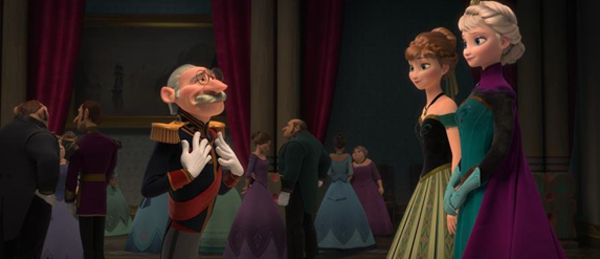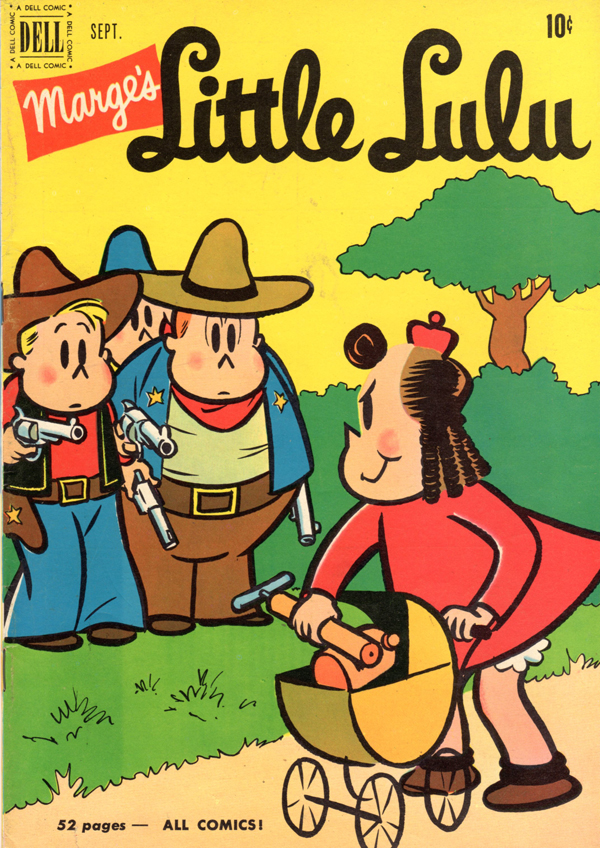
"What's New" Archives: March 2014
March 22, 2014:
It's John Stanley's 100th Birthday
March 12, 2014:
March 22, 2014:
It's John Stanley's 100th Birthday
The presiding genius of the wonderful Little Lulu comic book of the 1940s and 1950s was born a hundred years ago today in New York City, the son of Irish immigrants. He wrote all of the Lulu stories from the first issue, in 1945, until the late 1950s. Stanley drew almost none of the Lulu stories after the first few Four Color issues, but he always drew the front covers, one of which, for the September 1951 issue, is above. This cover intrigues me; in today's hyper-protective environment, would any publication for kids dare to suggest that bug spray might be a suitable weapon in warfare among children?
March 12, 2014:
Memorials
Michael Sporn. From Michael's widow, Heidi Stallings, comes word that a memorial celebration of his life will be held on Monday evening, March 31, at the Academy Screening Room at the Lighthouse, 111 E. 59th Street, between Park and Lexington Avenues in New York City. The celebration will begin at 7 p.m., with a reception to follow at a venue not yet determined. Phyllis and I will be there.
Robin Allan. The British author of the landmark study Walt Disney and Europe died on January 6 at the age of 79, an event too little remarked in the animation world with the notable exception of Maureen Furniss' warm Animation Journal post. Robin and I met only once, at the Disney Studio in 1992, but we were in touch frequently over the years, by mail and occasionally by phone, and I always valued him as a friend and one of the very best Disney scholars.
Robin's story, as told by his wife, Janet, in a brief biography shared with friends, was more remarkable than I realized, beginning with a childhood in the African country of Malawi, when it was the British colony Nyasaland, and continuing with employment in places as diverse as Kuwait, Malta, and Iran, before he settled in as a lecturer at the Manchester College of Adult Education. His perseverance in pursuing what Janet calls "his Disney dream" resulted in the completion of his Ph.D. in 1993, on "European influences on the animated feature films of Walt Disney," and ultimately the publication of his book, in 1999. In the meantime, he had taken early retirement and set up what Janet calls "a theatre-going coach service 'Intertheatre' which took enthusiasts all over the country on theatrical and literary journeys." He was recurrently ill the last nine years of his life, but remained active almost until the end.
Movie Thoughts
I have been occupied the last few months with work on Funnybooks: The Improbable Glories of the Best American Comic Books, but with that book now finished and in production, I finally have time to think about this website again, and specifically about some of the few movies I've had time to see.

Frozen. When Phyllis and I saw this latest Disney animated feature, we sat in front of three little girls who had seen it before, probably more than once, and who sang along with it enthusiastically. I was charmed, but I knew then that anything I might have to say about Frozen would be utterly superfluous. The movie had connected with its target audience, and I was definitely not part of it. (I know people my age who loved Frozen, but they saw it with their granddaughters.) I'll make a few comments, anyway.
My lingering impression is that Frozen is the apotheosis of the "Disney Princess" movie. The girls in the film, Anna and Elsa, are not fairy-tale princesses but are instead, much more than their predecessors in other Disney features, idealized versions of the girls in the audience. The gap between the princesses on the screen and the "princesses" in the audience has been bridged. Not without a little awkwardness, to be sure. When Anna and Kristoff finally kiss, it's anticlimactic, the real climax having occurred when the sisters reconcile; but, of course, mending a breach with a sister would typically be more important to a little girl than a kiss from a boy. The Disney people seem to have realized that by making the movie appeal so powerfully to little girls, they could shrug off any concerns that a "princess" label might discourage boys from seeing it.
Throughout, Frozen is an expertly machined piece of entertainment. When Elsa sings "Let It Go," it's a dazzling commercial for the inevitable Broadway version, and no doubt many people will be tempted to see that show just to learn how Disney's theatrical wizards have translated all the snow and ice into stage machinery. But ultimately, the air of calculation, the sense that the commercial possibilities were weighed with a jeweler's precision at every moment during production, to the exclusion of possibilities of other kinds, makes Frozen tiresome as even other recent Disney animated features are not. For one thing, I saw not a hint of any progress toward making CGI human characters look more like real beings and less like plasticine dolls.
Movies manipulate; that's what they do. But usually not so relentlessly and single-mindedly. Unlike those little girls sitting behind me, I don't think I'll see Frozen again.
Saving Mr. Banks. This Disney movie's version of events surrounding the production of Mary Poppins is so obviously and clumsily fictional that I can't believe it will have any lasting impact. I don't think anyone in the future will call Tom Hanks to mind when the name "Walt Disney" is spoken. But I enjoyed seeing the exteriors shot at the Disney studio, where I spent a lot of time over the years, and trying to figure out how the action had been staged to avoid showing buildings that were not there fifty years ago. And then there were cute details like Hanks's Smoke Tree Ranch tie pin.
I also found myself speculating what it was about this story might have appealed to Disney executives, Robert Iger, in particular. The movie, is of course, about how Walt cajoles P.L. Travers into letting him make a movie of Mary Poppins by identifying and exploiting her weakness, her love for her drunken father. Her book passes into Walt's hands and becomes an enduringly popular film. On reflection, how could such a story not appeal to a man whose tenure as Disney's CEO has been distinguished most by his negotiations to buy other people's ideas—Pixar, Star Wars, Marvel Comics—and transform them into something more "Disney"? Who knows, maybe in 2064 there'll be a movie about how Bob Iger found the weak spot in George Lucas's psyche.
Gravity. Easily the best animated film of the year. Well, a combination film, actually, as much of one as The Three Caballeros, but wonderful, regardless (and with much better animation and much better acting than any other combination film I can think of). I've read some persuasive complaints about Gravity's lack of scientific accuracy, but this is a case, unlike Saving Mr. Banks, where any falseness is self-justifying.
Third Man on the Mountain. Not a new movie, of course, but rather a 1959 Disney live-action feature. There's a page on this site about the filming of that very good movie, and thanks again to Werner Schrämli, I've added another photo and some more information to it. You can go directly to the new material by clicking on this link.
From Donald Benson: I was really impressed up until they left the ice palace. Then it felt oddly standard with lots of mechanics about getting characters back in the same place, a villain with a plot and some sort of magic spell with an increasingly obvious built-in escape clause or whatever.
Give Disney credit for presenting the villain as one of the romantic leads in the marketing—it made that twist a surprise, although his smug scheming thereafter was all by the numbers ("I'm greedy! And unethical! Ha ha!" What if he really did love the younger sister, but was still intent on claiming the throne?). And nice to see a film that's not all about landing a prince, or self-consciously about not landing a prince (although this may be the first time love at first sight didn't work out in one of these movies). At fadeout we have the queen happily unattached, and her sister just sort of chatting up a boy she would have promptly wedded in any other film.
It says something about expectations that the absence of a double wedding is a major argument for gay subtext. One could just as easily argue for a Mormon subtext (wish I could take credit for this: The nonconformist, unable to make it through the expected ritual, runs off to build what looks like her own cathedral. Also, the ending with two girls and one boy left standing.) Anyway, I'm sure they're already working on Frozen 2: Not That There's Anything Wrong With That. In previous sequels they felt obliged to fix up Quasimodo, Mater the tow truck, and even one of Cinderella's wicked stepsisters.
Liked Tangled better; perhaps because it was more frankly a broad comedy where modern gags and attitudes felt at home.
MB replies: I like the idea of a villain who loves the younger sister but wants to kill her anyway, for purely dynastic reasons. Sounds very medieval, and entirely believable in that context. But there is, of course, nothing medieval about Frozen, which is high school on ice.
[Posted March 18, 2014]
From Floyd Norman: As always, I enjoyed your comments on the two Disney films, Frozen and Saving Mr. Banks. Even though it was simply Disney entertainment, the P.L. Travers tale had a special resonance with me. After all, I was on the Walt Disney Studio lot back in 1961 when these events took place. Considering Hollywood's usual fabrication, I found it amazing how much the movie got things right. Why did Iger give the nod to this project? I had heard the script was being shopped around town. This pretty much obligated Disney do the film lest some other studio totally screw things up.
I sat in the Disney studio theater and wept while watching the movie. Perhaps I was simply remembering a Disney Studio we'll never see again.
[Posted March 19, 2014]From Michael Jones: We picked up the Blu-ray disc today, and you might be interested to know that in the ‘Making of’ there are lots of discussion with Alice Davis, and how many, many parts in the movie were actually inspired by work her late husband Marc did for Walt on the Snow Queen attraction that was never built of course. An example cited is here, courtesy of Jim Hill
[Posted March 24, 2014]
From Kevin Hogan: I haven’t seen Mr. Banks yet, but I hope to. I’m hoping Tom Hanks as Walt Disney is less jarring in the film than in the commericals.
I was disappointed by the computer animation in Frozen, and the human surface rendering was particularly disappointing after Disney seemed to be making headway in that area during Tangled. The puppets are returning with a vengeance (From what I’ve read, the movie was put together relatively quickly after several stops and starts—maybe the reason for the relapse). The film was saved, in the public’s eye, by Broadway-style tunes…. It’s not just little girls who love it, by the way. My Les Miserables-loving wife has been singing “Let It Go” almost daily. Also, I think the simplified (and yes, manipulative) story was a welcome change from the overly busy Disney films of the past decade. I thought it was okay—the first film in a while that I was not immediately prepared to forget in full.
Oh, and by the way, the snowman was incredibly superfluous.
[Posted April 5, 2014]
